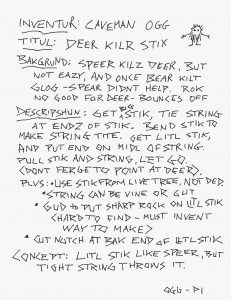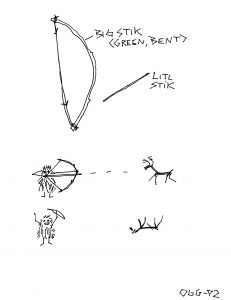By Ben Langlotz
|
November 8, 2022
|
Firearms, Firearms Industry Advice, How To, Patent
|
0 Comments
HOW A “CAVEMAN” PATENT CAN AFFORDABLY SECURE YOUR INVENTION
It’s been 10 years since I wrote this. Back then, the biggest change in patent law in my lifetime took effect. And it changed everything.
The big change was that patent rights for an invention go to the first to file a patent application, not the first to invent (who has documents showing he invented it first). This means that if you show a new product at SHOT, anyone can rush off and file a patent application on it. Unless you can prove in court that they learned it from you (easier said than done)- they win.
You lose. Not only do you lose the chance to control your own invention (either selling it exclusively at a profit premium, or receiving royalties from others) but the “first to file” patent owner can prevent you from using your own invention! And if you had invested in trying (too late) to patent the invention yourself, that investment would be wasted.
It could be a competitor, or an opportunist, or even a foreign SHOT Show visitor who decides to exploit your invention. And they may even come around in a few years with a smile, offering you the chance to pay them 5% of your sales revenue in exchange for them not shutting down your product line.
So, there’s a new rule.
The new Rule:
File something (a “Caveman Patent”)
BEFORE you reveal any new invention
What you must file before revealing any invention is legally called a “Provisional Application for Patent.” But I call it a “Caveman Patent” (I’ll explain why a little later in this newsletter). It has one and only one purpose: to make you the “first to file”, thus securing your right to pursue real patent protection down the road.
Your “Caveman Patent” will never turn into an actual enforceable patent, but it will secure your right to safely pursue that investment in a timely way, within a year of the time the invention was revealed. (And don’t be confused by the fact that there is also a different one-year period from the Provisional filing to file the non-provisional – that is there for top grade (expensive) Provisional applications, not for our affordably basic “Caveman” filing).
A Caveman patent provides another advantage: Suppose you decide not to invest in patenting your invention. Maybe you figure the sales revenue over the next 20 years will be too small, or the product will have a short lifespan, or you have other inventions to protect with a limited legal budget. Most patentable inventions are never patented, after all. But if you file a “Caveman Patent”, you can enjoy the benefit that no one else can patent the same invention, and freeze you out. This is like a “defensive publication.” (Incidentally, for this one defensive benefit, it doesn’t need to be a patent filing; if your invention were published anywhere, such as in this newsletter, it would prevent anyone else from enjoying patent rights if they later filed a patent application.) A Caveman patent is good defense as well as great offense.
So, the benefits of filing a Caveman Patent are:
- Secures your right to protect your invention with a future patent application by keeping others from taking away your patent rights. Plus it buys you time to decide whether to invest in a full patent application.
- Keeps others from patenting your invention, avoiding the unthinkable consequence that you could be prevented from making and selling your own invention.
What does a “Caveman Patent” Cost?
A. Free? B. $1500? C. “Almost Free”?
A regular, full (“non-provisional, utility”) patent application is a major investment, with extensive hours of attorney time to develop and articulate a strategy, and supported by substantial detail in describing and explaining an invention. “Caveman Patents” are different.
With a “Caveman Patent”, there’s very little attorney work involved (except for all the free advice and assistance you’re getting right now). Basically, it’s a do-it-yourself filing. And it’s so easy, that even a caveman can do it. Same for talented engineers who hate to write up documentation, and executives who are too busy to spend hours on write-ups!
Because I didn’t want Congress to charge my active patent clients more money in legal fees, I came up with a way that your “Caveman Patent” filings are essentially free of legal fees. It’s simply this: a “Caveman” filing is a flat fee of $1500 for my office to:
- Receive your disclosure,
- Review it to verify if it’s legally adequate, and give feedback on needed changes,
- Prepare filing documents,
- File it formally with the U.S. Patent and Trademark Office,
- Calendar essential deadlines, and
- Receive, log, and forward to you confirming documents from the U.S. Patent and Trademark Office.
Plus, we pay the U.S. Patent and Trademark Office filing fee.
Now, here’s why it’s “Free”: There’s a scenario I want to protect you from – You have 4 inventions per year that have some promise at the outset. You can’t risk a competitor filing before you on any of them. But in the end, only one per year will turn out to be worthy of the investment in full patent protection.
So adding $6000 per year to your legal budget because Congress changed the law simply wouldn’t be fair to you. Which is why your legal fees for every “Caveman” filing will be accrued and credited against any future full patent application filings. If you have, say, 10 Caveman filings, your $15,000 in “Caveman” legal fees paid would be credited toward the legal fees of your next patent application. And that future patent application doesn’t even have to be one you filed a “Caveman” on (it might be a critical new invention that deserves a full patent application immediately).
Thus, if you expect to be filing a full patent application sometime before the end of the following year, your Caveman filings are “almost free.”
How to Prepare your Own “Caveman” Disclosure
The key to this “almost free” Caveman deal is that you do the work yourself, and we only give it a brief review for adequacy. If it’s not adequate, and you need our help, we’ll advise about additional legal fees that might be incurred to make it ready for filing, if you wish.
Email me for an extensive Drafting Guide including template, but here’s a summary of all it takes to prepare what I need to do a Caveman filing for you:
- Title
- Background (what closest technology it improves upon)
- Description (what it is, how it works, how it’s made)
- Drawing (at least a little sketch, but a pile of pdfs from your CAD system is great)
- Concept – optional (what makes it unique)
And to prove that it’s so easy that a caveman really can do it, here’s a perfectly adequate disclosure (sample on the next couple of pages) that my office could file to secure the rights of a caveman inventor that just contacted my office.


Ogg did some good work, and we don’t need to change anything to make it ready to file. If Ogg invents a way to make sharp rocks next month, we’ll just file another “Caveman” application. Then, when Ogg lines up his investors, he’ll be secure in filing a full patent application for both the main invention, and for the arrowhead techniques. And all Ogg’s legal fees will be applied to that patent application.
But it’s important to realize the limitations of a Caveman application. The main one is that it’s a temporary way to preserve rights. It will never turn into an actual patent. It simply buys time until that larger investment. And when we file a full patent application, we will be referring to Ogg’s disclosure, but will probably write the patent application from scratch in the best way to preserve strategic rights. It’s even likely that by the time we get to the full application, Ogg will have other little improvements that we’ll incorporate, and we might even suggest some ideas and strategies.
Now, Ogg doesn’t need to worry about someone else filing first. And these days, it’s easy and cheap to file fast, so you don’t want to be the last one to figure out how easy and cheap it is. (Someone could walk around the SHOT Show, find 100 new inventions, spend an hour writing up each, and in a few weeks, and with $15,000 in filing fees have an immense portfolio of potential patent rights to threaten our industry with.)
If you have an invention, and aren’t sure what to do, just call me, or email us to get that Drafting Guide.
Sometimes, you need to think like a caveman to be on the cutting edge.